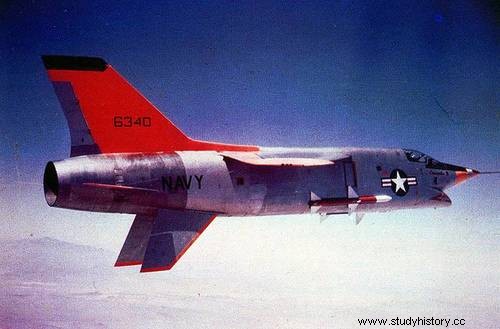
The Vought XF8U-3 Crusader III was an aircraft developed by Chance Vought , in response to the competition launched in December 1955 by the US Navy to produce a naval interceptor of the Mach 2+ class. This aircraft was a competitor to the McDonnell F4H Phantom II to succeed the (future) famous Chance Vought F8U-2 Crusader.
Although based in spirit on the F8U-1 and the F8U-2, and using the same initials (F8U) of designation of the old system of the Navy, this apparatus had only few elements in common with its predecessors .
Study and development
In parallel with the F8U-1 and -2s, the design team was also working on a larger aircraft with even more performance, referenced internally as the V-401. Although the exterior similar to the Crusader shared with it design cues like variable incidence wings, the new fighter was larger and powered by the Pratt &Whitney J75-P-5A engine generating 131 kN of thrust with afterburner .
To cope with supersonic flight conditions, it was fitted with large vertical ventral fins under the tail that rotated to a horizontal position for landing. To ensure sufficient performance, Vought had provided a liquid-fueled Rocketdyne XLF-40 rocket engine with 35.6 kN of thrust in addition to the turbojet engine. The avionics included an AN/AWG-7 gunnery computer, AN/APG-74 radar, and AN/ASQ-19 datalink. The tracking system was designed to be able to track six aircraft and engage two simultaneously.
Due to significant changes from the F8U-1, the F8U-2 had been referred to by some as the "Crusader II" and, accordingly, the XF8U-3 was officially labeled the "Crusader III."
Operational History
The XF8U-3 made its first flight on June 2, 1958. Despite claims in numerous books and journals that the aircraft had reached Mach 2.6 at 35,000 feet (10,670 m), during its tests, the maximum speed reached ( only once) was Mach 2.39, while its normal speed did not exceed Mach 2.324. On August 14, during its 38th test flight, the aircraft exceeded Mach 2.0 in level flight, well ahead of its rival, the F4H-1.
Some sources claim that Vought was aiming for a maximum speed of Mach 2.9 (thanks to the booster from a rocket installed in the tail) although the airframe (in aluminum) and the windshield were not designed to withstand the heat with a speed of more than Mach 2.35. The ceiling reached was found to be over 76,000 feet (23,170 m).
Showdown flights with the Crusader III's main competitor, the future McDonnell Douglas F-4 Phantom II, showed that the Vought concept had a definite advantage in handling. John Konrad, Vought's chief test pilot, later said that the Crusader III could fly in circles around the Phantom II. The thrust-to-weight ratio (T/W ratio) in combat was close to unity (0.97), while that of the F4H was only 0.87. However, the XF8U-3 solo pilot was easily overwhelmed by the workload required to fly the interceptor and fire the Sparrows missiles which require constant radar illumination of the target, while the Phantom II had on board a radar intercept officer, the R.I.O..
Furthermore, with the perception that the era of guns was now a thing of the past, the Phantom's considerably larger payload and ability to perform air-to-ground as well as air-to-air missions overwhelmed the Vought's fast but single-tasking fighter.
For similar reasons, the Phantom was expected to replace the Navy's F-8 Crusader as the primary day air superiority fighter during the Vietnam War, although it was originally billed as a missile-armed interceptor as a complement to day fighters. like the Crusader.
With five aircraft built, the F8U-3 program was cancelled. Three aircraft flew during the test program and then (along with two other airframes) were transferred to NASA for atmospheric testing, as the Crusader III was capable of flying higher than 95% of Earth's atmospheric layer. NASA pilots flying at Patuxent River routinely intercepted and defeated US Navy Phantom IIs in mock combat, until complaints from the Navy ended the harassment.
All Crusader IIIs were later scrapped.
Maximum speed :2,928 km/h
Mass :9,915 kg
Length :18 m
Wingspan :12 m
Distance range :1,040 km
Engine type :Pratt &Whitney J75
First flight :June 2, 1958
